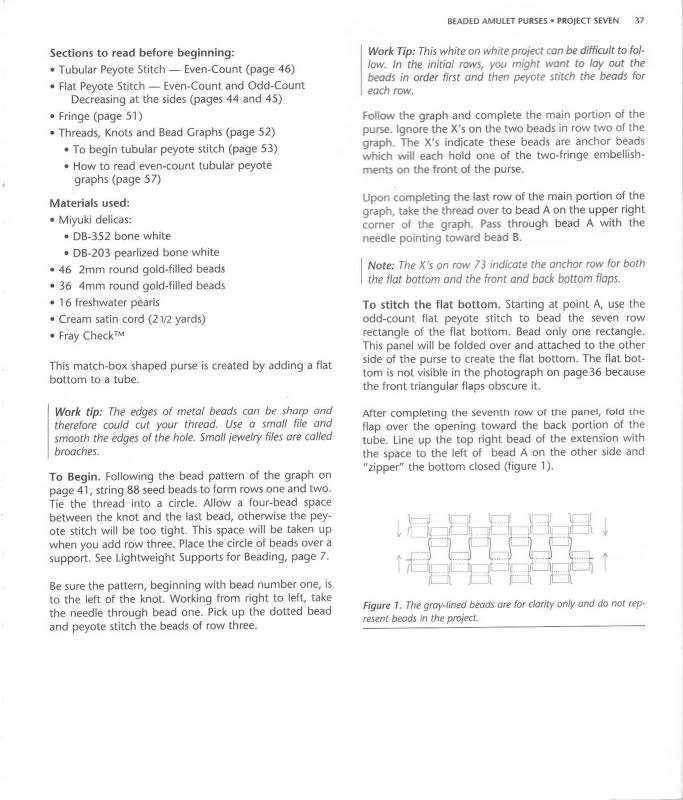37

BIADED AMULET PURSES • PROIECT SEVEN J7
Sections to read before beginning:
• Tubular Peyote Stitch — Even-Count (page 46)
• Fiat Peyote Stitch — Even-Count and Odd-Count
Decreasing at the sides (pages 44 and 45)
• Fringe (page 51)
• Threads, Knots and Bead Craphs (page 52)
• To begin tubular peyote stitch (page 53)
• How to read even-count tubular peyote graphs (page 57)
Materials used:
• Miyuki delicas:
• DB-352 bonę white
• DB-203 pearlized bonę white
• 46 2mm round gold-filled beads
• 36 4mm round gold-filled beads
• 16 freshwater pearis
• Cream satin cord (21/2 yards)
• Fray Check™
This match-box shaped purse is created by adding a fiat bottom to a tubę.
Work tip: The edges of metal beads can be shorp and therefore could cut your thread. Use a smali file and smooth the edges of the hole. Smali jewelry files are called broaches.
To Begin. Following the bead pattern of the graph on page 41, string 88 seed beads to form rows one and two. Tie the thread into a circle. Allow a four-bead space between the knot and the last bead, otherwise the peyote stitch will be too tight. This space will be taken up when you add row three. Place the circle of beads over a support. See Lightweight Supports for Beading, page 7.
Be surę the pattern, beginning with bead number one, is to the left of the knot. Working from right to left, take the needle through bead one. Pick up the dotted bead and peyote stitch the beads of row three.
Work Tip: This white on white project can be difficult to fol-Iow. In the initiol rows, you might want to lay out the beads in order first and then peyote stitch the beads for each row.
Follow the graph and complete the main portion of the purse. Ignore the X's on the two beads in row two of the graph. The X's indicate these beads are anchor beads which will each hołd one of the two-fringe embellish-ments on the front of the purse.
Upon completing the last row of the main portion of the graph, take the thread over to bead A on the upper right corner of the graph. Pass through bead A with the needle pointing toward bead B.
Notę: The X's on row 73 indicate the anchor row for both the fiat bottom and the front and back bottom fiaps.
To stitch the fiat bottom. Starting at point A, use the odd-count fiat peyote stitch to bead the seven row rectangle of the fiat bottom. Bead only one rectangle. This panel will be folded over and attached to the other side of the purse to create the fiat bottom. The fiat bottom is not vislble in the photograph on page 36 because the front triangular fiaps obscure it.
After completing the sevenih row of the panel, foid the flap over the opening toward the back portion of the tubę. Linę up the top right bead of the extension with the space to the left of bead A on the other side and "zipper" the bottom closed (figurę 1).

Wyszukiwarka
Podobne podstrony:
BEADED AMULET PURSES • PROJECT SIX 31 Sections to read before beginning: •
BEADED AMULET PURSES • PROJECT TWO 1J Sectlons to read before beginning: •
BEADED AMULET PURSES • PROIECT THREE 17 Sections to be read before beginning: • Tu
BEADED AMULET PURSES • PROIECT SEVEN i ) Figurę 4 To make the triangular points at the top of the pu
BEADED AMULET PURSES • PROJECT FOUR 21 Sections to bo read before beginning: • Tub
BfcADŁO AMULET PURSCS • PRO
BEADED AMULET PURSES • APPENDIX B 57How to read even-count tubular peyote graphs The tubular peyote
BEADED AMULET PURSES • PROJECT ONE 9 BEADED AMULET PURSES • PROJECT ONE 9 Sections to be read before
14 PROIECT TWO • BEAOEO AMULET PURSES To make the triangular flap. After completing the last row of
więcej podobnych podstron